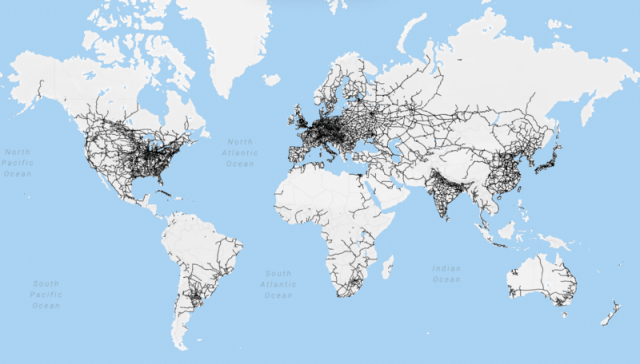It’s been almost 200 years since the first train journey between Liverpool and Manchester in 1830, and yet we still don’t fully appreciate how good trains are for moving people and goods.
To keep it short: trains move more people and goods in a single trip than buses or trucks. They pollute less, and they’re safer too.
This post could end here — but I’ve got time to write, and I like trains.
Good rails matter
According to “The State of the EU’s Rail Infrastructure” report by Transport & Environment (T&E), rail moves 7% of the EU’s passenger traffic while contributing only 0.4% of greenhouse gas emissions in the transport sector. The report also notes that “if you were to move 1,000 tonnes of freight from Rotterdam to Vienna, you would emit 100 tonnes of CO2 less by train than by truck”.
Still, 75% of goods today travel by road. Why? Because companies operating under capitalist logic won’t invest in rail for the sake of the climate. They never will — unless the crisis directly threatens their business.
So the responsibility (almost an obligation) to build a truly connected, efficient, and convenient European railway system lies with the EU and its member states.
The top priority should be to standardize railways across Europe to simplify cross-border connections.
As you can see in the image, Europe has the most extensive and complex rail network in the world — but every country has its own system. Coordinating, upgrading, maintaining, and expanding rail infrastructure in a landscape of differing standards is a nightmare. Funding and investments are extremely costly.
T&E estimates that investments will need to reach around €500 billion, and the Trans-European Transport Network (TEN-T) regulation sets these milestones:
Core network investments by 2030
Extended core network investments by 2040
Comprehensive network investments by 2050
In addition, the regulation requires that:
The European Rail Traffic Management System (ERTMS) be implemented within the same timeframes.
By 2040, 75% of passenger rail sections in the core and extended networks allow speeds up to 160 km/h.
Track gauge harmonization and intermodality be ensured.
This is a massive amount of money — and too often, it flows into megaprojects while smaller but crucial upgrades in rural areas (like adding double tracks) are forgotten. Local communities are rarely involved in infrastructure planning, which doesn’t help either.
Enhancing Railways to Decarbonize Transport
A report by the Community of European Railway and Infrastructure Companies (CER) notes that as of “as of 2022, 56.9% of EU railway lines were electrified, supporting 80% of rail traffic, and about 52% of that energy came from renewables.

Still, there are weak points in rail’s energy supply. Prices remain higher than before the energy crisis, making it harder for rail companies to compete with road transport operators who benefit from relatively stable oil prices. There’s also a lack of long-term access to clean energy.
To address these issues, CER propose to:
Ensure fair access to affordable and clean electricity: through long-term energy contracts, Power Purchase Agreements (PPAs), and fair energy taxation.
Promote best practices in energy procurement: guiding companies on contract strategies and encouraging innovation like in-house renewable production and risk-hedging mechanisms.
Prioritize renewable access (wind, solar) for energy-efficient sectors like rail, creating long-term price stability.
Increase tax incentives, state aid, and innovative contracts.
(Or, you know, just nationalize the railways and coordinate better between state companies…)
Pollution
We’ve already talked about emissions, but it’s worth returning to this.
One of the main goals set by the European Commission in its Sustainable and Smart Mobility Strategy — part of the EU Green Deal is to double the rail freight traffic by 2050 and increase transport by inland waterways and short sea shipping by 25% by 2030.
As the European Environment Agency points out, this would significantly reduce greenhouse gas emissions, air pollution, and noise pollution.
Shifting goods from road to rail or waterways means fewer vehicles on highways and more efficient movement of large volumes of products.
There are more topics to explore — like the liberalization of railways (which simply doesn’t make sense, and since 2007 hasn’t changed much), dual-use investments (military and civilian), and research and innovation.
Maybe I’ll get to those next time.



